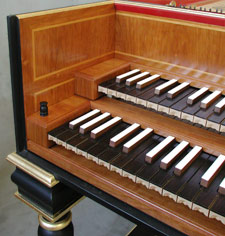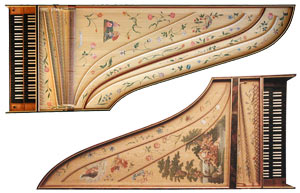Small
harpsichord after Hieronymus Hass (upper photo)
Large harpsichord after Hieronymus Hass (lower photo)
 Throughout
the Baroque period, culture and sophistication were terms uniquely linked
with France whose array of native musical talent was perhaps matched
only by that available in Germany. Though we now perceive greater artistic
value in German than French music, the reverse was true in the eighteenth
century. The German states, by and large, were not so prosperous as
to be able to afford great numbers of harpsichords. Clavichords, cheap
and numerous, were the order of the day. Little wonder, then, that in Germany during
this time harpsichord making was largely a fragmented affair.
Throughout
the Baroque period, culture and sophistication were terms uniquely linked
with France whose array of native musical talent was perhaps matched
only by that available in Germany. Though we now perceive greater artistic
value in German than French music, the reverse was true in the eighteenth
century. The German states, by and large, were not so prosperous as
to be able to afford great numbers of harpsichords. Clavichords, cheap
and numerous, were the order of the day. Little wonder, then, that in Germany during
this time harpsichord making was largely a fragmented affair.
 Though
we tend to refer to them as such, coherent schools of harpsichord making
were not so much national schools, as city schools. In this view, Flemish
clavesingels were expressions of the Antwerp school, French clavecins
the products of Parisian builders and English harpsichords the products
of London makers. There were outliers on the flanks of each school,
but the money that would allow a school of harpsichord making to flourish
could only be found in the cities. Hamburg alone, in the vast reaches
of Germany, had sufficient financial activity to support a significant
level of secular musical culture as well as its own school of harpsichord
making. Those instruments by other German makers, which did not resemble
those from Hamburg, were seldom similar to anything else and were often
simple, rustic and hearty.
Though
we tend to refer to them as such, coherent schools of harpsichord making
were not so much national schools, as city schools. In this view, Flemish
clavesingels were expressions of the Antwerp school, French clavecins
the products of Parisian builders and English harpsichords the products
of London makers. There were outliers on the flanks of each school,
but the money that would allow a school of harpsichord making to flourish
could only be found in the cities. Hamburg alone, in the vast reaches
of Germany, had sufficient financial activity to support a significant
level of secular musical culture as well as its own school of harpsichord
making. Those instruments by other German makers, which did not resemble
those from Hamburg, were seldom similar to anything else and were often
simple, rustic and hearty.
Of
the two major families of makers in Hamburg, Zell and Hass, we have
chosen to produce the instruments based on the designs and practices
of the latter. The Hass harpsichords offered here have a full and forthright
tone whose rich, organ-like sonorities can be put to stunningly effective
use in a great variety of musical styles, especially for the music of
Bach. The sense is unavoidable that, when played on these instruments,
the music of Bach and his contemporaries has finally come home once
more. For more information about our German double-manual, see
Hendrik Broekman's article.
 Our
German double-manual harpsichords are disposed as either 2 x 8', 1 x
4', buff; or 2 x 8', 1 x 4', 1 x 16', lute, buff. The keyboards retain
the proportions of the originals which are almost exactly those of the
modern piano. Nevertheless, the actions are responsive and lively enough
to play French music convincingly.
Our
German double-manual harpsichords are disposed as either 2 x 8', 1 x
4', buff; or 2 x 8', 1 x 4', 1 x 16', lute, buff. The keyboards retain
the proportions of the originals which are almost exactly those of the
modern piano. Nevertheless, the actions are responsive and lively enough
to play French music convincingly.
Both instruments
are offered in a simple decor - painted in two colors on a matching
trestle stand. The keywell surrounds are veneered, inlaid and crossbanded
to coordinate well with the ebony and bone key coverings. Most Hamburg
harpsichords were sumptuously decorated with chinoiserie inside
and out, floral designs on the soundboard and were placed on impressive
stands. If desired, we will gladly arrange these details as well.
German
double-manual harpsichords - Offering
Sheet

Listen
to the large German double...
You
can hear excerpts from a demonstration
CD we have prepared for this instrument:
~
A Note About The Files ~
Not all mp3 files are equal! The sound of a harpsichord is particularly
difficult to compress satisfactorily. The bit rate we have chosen
for these samples is the lowest that reproduces the original recording
with negligible loss. Download times will vary widely depending
on your setup and the quality of your connection. On a 28K
Internet connection, the shorter sound sample may take from about
5 to over 10 minutes to download. If you have a fast connection (T1,
cable modem, DSL) please try the long sample - you may expect download
times substantially under a minute.
~ Problems Playing the File ~
If you cannot play the file through your web browser, PC users with
the Microsoft browser can right click on the link, then choose the
"Save target" option to download the file, then use an MP3
player (or a the Windows media player) to listen to it.
We now have available a demonstration
CD of the large German double ($10.00 ppd. in U.S.). Please -inquire
via our contact form.
